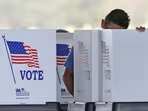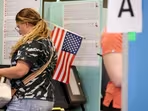US Election Results: Six key questions that will shape the race to White House
As Americans head to the polls, the race between Vice President Kamala Harris and former President Donald Trump remains razor-thin. As it seems to be a long wait before the election is called in United States, here are six pivotal factors that could determine who occupies the White House.

The Gender Gap: Can Kamala become first woman president of United States?
The 2024 election has become a defining moment in gender politics. Harris has garnered strong support among female voters, leading 53%-36% in a recent poll. Her campaign has heavily emphasized issues like reproductive rights post-Roe v. Wade, aiming to consolidate her edge with women, who traditionally vote at higher rates than men. Conversely, Trump dominates male voters, leading by similar margins. The election could hinge on which candidate mobilizes their gender base more effectively.
Can "Bro Vote" inspired by Elon Musk and Joe Rogan help Trump win?
Trump’s campaign has strategically targeted young, non-college-educated men, a demographic often overlooked in past elections. His appearances at UFC events, college football games, and podcasts aim to galvanize this group. These voters, though less likely to participate historically, represent about 11% of the electorate in key battleground states. Trump’s success could depend on turning out these "low-information" voters.
Will senior voters shift from red to blue this year?
Historically leaning Republican, senior voters might tilt toward Harris this time, especially older women concerned about rising costs and social safety nets. Polls suggest Harris is leading narrowly among voters 65 and older, with a significant advantage among senior women. This "silver surge" could be critical in Midwestern battlegrounds like Iowa, Pennsylvania, and Michigan, where Harris is already showing promising leads among seniors.
Will Blacks, Latinos and Indians see through Trump's poll gimmicks?
Trump has made slight inroads with Black and Latino voters, focusing on younger males within these communities. While Harris still leads Harris leads Trump 84%-16% among Black voters in Pennsylvania and 75%-25% in Michigan, the margins are slimmer than in 2020. If Trump can slightly improve his performance in urban centers like Philadelphia, Detroit, and Milwaukee, it could offset Harris’s gains among suburban white voters. Harris, however, is polling better with white voters than Biden did, potentially compensating for any minority voter slippage.
Will Puerto Rican scuttle bite Trump's chances to win?
A backlash against offensive comments made at a Trump rally could energize Puerto Rican voters in Pennsylvania, a critical swing state. Harris leads significantly among this group, and their turnout could be decisive. With Pennsylvania’s 19 electoral votes in the balance, the reaction of this demographic may prove pivotal.
Will the "Blue Wall" that helped Biden win 2024 help Kamala?
The Rust Belt states of Pennsylvania, Wisconsin, and Michigan, known as the "blue wall," have historically voted as a bloc. Harris needs to secure these states to bolster her path to 270 electoral votes. Trump’s chances improve significantly if he can flip any of these states, especially Pennsylvania. Winning Pennsylvania would allow Trump multiple paths to victory, particularly if he secures key Sun Belt states like Georgia and Arizona.
Disclaimer: The copyright of this article belongs to the original author. Reposting this article is solely for the purpose of information dissemination and does not constitute any investment advice. If there is any infringement, please contact us immediately. We will make corrections or deletions as necessary. Thank you.
Title:US Election Results: Six key questions that will shape the race to White House
Url:https://www.investsfocus.com









